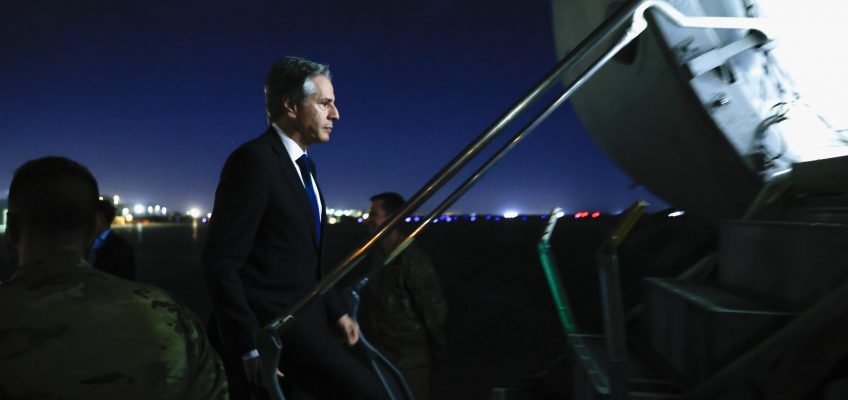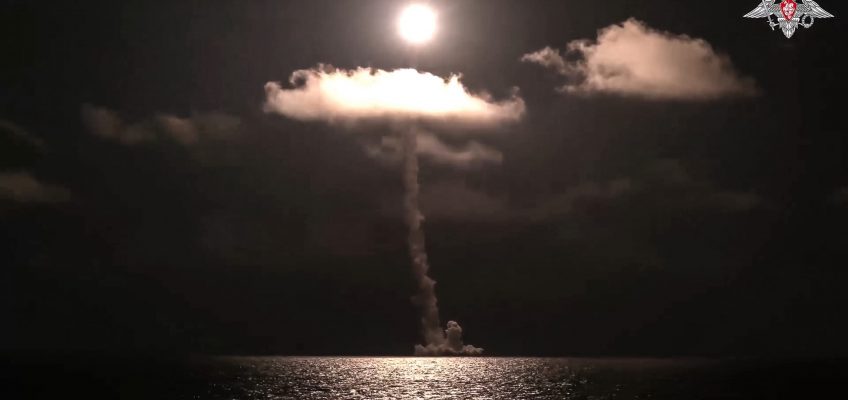RAMALLAH, West Bank — Secretary of State Antony Blinken took his diplomatic push on the Israel-Hamas war to the occupied West Bank on Sunday, trying to assure Palestinian President Mahmoud Abbas that the Biden administration was intensifying efforts to ease the plight of Gaza’s civilians and insisting that Palestinians must have a main say in whatever comes next for the territory after the conflict.
Blinken later flew to Baghdad for talks with Iraqi Prime Minister Mohammed Shia al-Sudani as American forces in the region face a surge of attacks by Iranian-allied militias in Iraq and elsewhere. U.S. forces shot down another one-way attack drone Sunday that was targeting American and coalition troops near their base in neighboring Syria, a U.S. official said.
President Joe Biden’s top diplomat traveled through the West Bank city of Ramallah in an armored motorcade and under tight security. It was his third day of shuttle diplomacy aimed at trying to limit the destabilizing regional fallout from the war and overcome what has been Israeli Prime Minister Benjamin Netanyahu’s refusal to consider a U.S. proposal for intermittent pauses in its attack on Hamas long enough to rush vital aid to Gaza’s civilians.
Netanyahu had pushed back Friday against the U.S. pressure to start implementing pauses in the fighting, saying there would be no temporary cease-fire until Hamas releases some 240 foreign hostages it is holding.
“This is a process,” Blinken told reporters on the matter Sunday. “Israel has raised important questions about how humanitarian pauses would work. We’ve got to answer those questions,” including how pauses would affect Hamas hostages. “We’re working on exactly that.’’
The Biden administration, while remaining the strongest backer of Israel’s military response to Hamas’ attacks on Oct. 7, is increasingly seeking to use its influence with Israel to try to temper the effect of Israel’s weeks of complete siege and near round-the-clock air, ground and sea assaults in Gaza, home to 2.3 million civilians.
Blinken’s meeting with Abbas in the West Bank came on the same day that Israeli planes bombed two refugee camps in Gaza, killing at least 53 people, according to health officials in Gaza. An Associated Press reporter saw the dead bodies of eight children brought in to a nearby Gaza hospital after one of those strikes. Israel’s military announced its forces had effectively split the Gaza Strip in two before an expected escalated assault on Hamas targets in the north.
As word spread of Blinken’s arrival in Ramallah, Palestinians turned out to protest U.S. support for Israel’s war. Demonstrators held signs showing dripping blood and with messages that included, “Blinken blood is on your hands.”
Neither Blinken nor Abbas spoke as they greeted each other in front of cameras and their meeting ended without any public comment.
The Palestinian Authority administers semiautonomous areas of the Israeli-occupied West Bank. It has not been a factor in the Gaza Strip since 2007, when Hamas seized control after winning in elections there a year earlier. Abbas himself is unpopular among Palestinians.
Blinken said in Baghdad that the Palestinian Authority “is playing a very important role right now in the West Bank in trying to keep stability there. That’s hugely important because no one wants another front in the West Bank or anywhere else, and they’re really stepping up under very difficult conditions to do the necessary work.”
He said that “what we all agree” is that in shaping a future for Gaza, the West Bank and “ultimately” for a Palestinian state, “Palestinian voices have to be at the center of that. The Palestinian Authority is the representative of those voices so it’s important that it play a leading role.’’
Abbas, however, said the Palestinian Authority would only assume power in Gaza as part of a “comprehensive political solution” to the Israeli-Palestinian conflict, according to the Palestinians’ official WAFA news agency. He also condemned Israel’s bombardment of Gaza as a “genocidal war” and urged Blinken “to immediately stop them from committing such crimes,” the news agency reported.
On his second trip to the Middle East since the war began, Blinken met with Netanyahu on Friday before holding talks in Jordan with Arab ministers Saturday. Netanyahu so far has rejected humanitarian pauses. The Arab officials pushed for an immediate cease-fire. Blinken said that would be counterproductive and could encourage more violence by Hamas.
U.S. officials believe that Netanyahu may soften his opposition to the pause idea if he can be convinced that it is in Israel’s strategic interests to ease the plight of Palestinian civilians in Gaza. The soaring death toll among Palestinians — more than 9,700, according to officials of Gaza’s Hamas-run health ministry — has sparked growing international anger, with tens of thousands from Washington to Berlin taking to the streets over the weekend to demand a cease-fire now.
Arab states are resisting American suggestions that they play a larger role in resolving crisis, expressing outrage at the civilian toll of the Israeli military operations but believing Gaza to be a problem largely of Israel’s own making.
Among Arab leaders, Blinken said it is clear that “everyone would welcome the humanitarian pause.” He said it “could advance things that we’re all trying to accomplish,” including freeing hostages, bringing in aid and getting out foreign citizens. On that last point, he said: “We’ve had important progress there in recent days but also real complications that come along with it. We continue to work through them.’’
In Baghdad, the talks touched on the security of U.S. forces.
“I made very clear that the attacks, the threats coming from the militia that are aligned with Iran, are totally unacceptable and we will take every necessary step to protect” American personnel, Blinken said before heading to Turkey. He said the prime minister expressed his own determination to stop the militia strikes.
The U.S. has deep concerns that Iran and its proxies, including several militia groups in Iraq, may take advantage of the situation in Gaza to further destabilize the Middle East. Already Iranian-backed militias have intensified rocket and other attacks on U.S. military facilities in Iraq and Syria, drawing at least one retaliatory strike from American forces.
Sunday’s attack by drone against a U.S. site in Syria was at least the 32nd on U.S. and coalition military facilities in Iraq and Syria since Oct. 17. To date there have been at least 17 attacks in Iraq and 15 in Syria. At least 21 service members have been injured by the attacks but all have returned to duty, the Pentagon said.
The same U.S. official who confirmed the U.S. shootdown of the drone said the drone strike was very similar to other recent attacks on U.S. personnel at bases in Iraq and Syria and is believed at this point to be linked to Iranian-backed militia. The official was not authorized to discuss the matter publicly and spoke on condition of anonymity.




